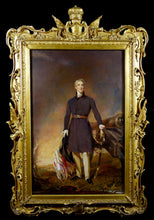Arthur Wellesley, 1st Duke of Wellington after John Simpson, Circa 1830
Adding product to your cart
Overall: 92cm (36in) x 62cm (25.5in)
Watercolour on paper laid down on board. Unsigned. Contained in a moulded gesso and gilt wood frame crowned with the Wellesley arms flanked by colours and canon beneath a ducal coronet. The Duke standing full length beside a canon. A typescript label verso reads ‘Arthur Wellesley, Duke of Wellington / Watercolour by / Henry Parsons Riviere (1811-88)’. Image size: 64cm (25in) x 42cm (16.5in).
Read more
The present portrait is after the large scale oil by John Simpson (1782-1847) in the Royal Hospital Chelsea. Simpson was one of Sir Thomas Lawrence's most active assistants, completing several of Lawrence’s unfinished portraits after his death in 1830. Simpson lived and worked in London, where he established a successful portrait painting practice and could claim many eminent sitters to his name. In 1834 he travelled to Portugal, where he was appointed portrait painter-in-ordinary to Queen Maria of Portugal. Two other full size version of Simpson’s Wellington portrait are recorded in the collection of the defunct Junior United Service Club at 116 Pall Mall, and in the collection of the Defence Academy of United Kingdom.
Henry Parsons Riviere (1811-88) watercolour painter, was the son of Daniel Valentine Riviere, a drawing-master, and studied at the Royal Academy schools. His earliest exhibited drawings were ‘An Interior’ and a copy of ‘The Triumph of Silenus,’ by Rubens, which appeared at the Society of British Artists in 1832. Two years later, in 1834, he was elected a member of the New Society of Painters in Water-Colours, where he exhibited 101 drawings before his retirement from it in 1850. In 1852 he became an associate of the older Society of Painters in Water-Colours. Subjects of Irish life and humour formed the staple of his exhibited works until 1865. About that time he gave up his practice as a teacher, and went to Rome, where he remained until near the end of his life. Between 1852 and 1888 he contributed 299 works to the exhibitions of the society. He exhibited also occasionally between 1832 and 1873 at the Royal Academy, British Institution, and Society of British Artists. He was an able copyist of the old masters in water-colours. Riviere returned finally to England in 1884, and died at 26 St. John's Wood Road, London, on 9 May 1888.








